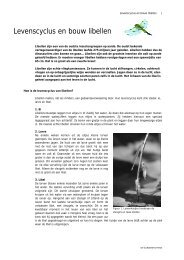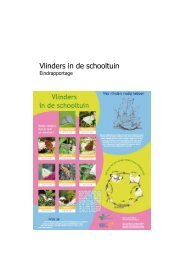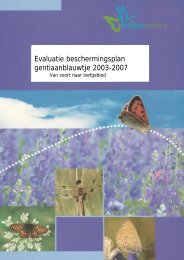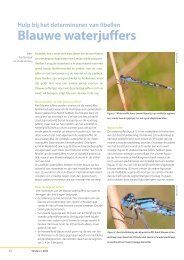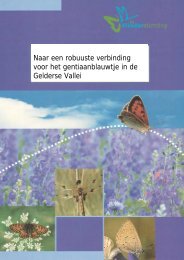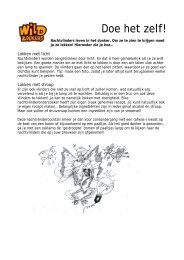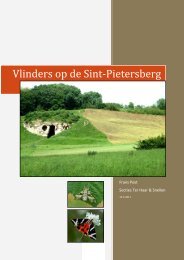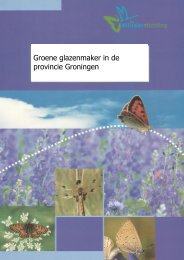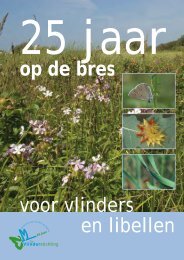Final Report October 2011 for the BBI-Matra/2008/015 ... - Vlindernet
Final Report October 2011 for the BBI-Matra/2008/015 ... - Vlindernet
Final Report October 2011 for the BBI-Matra/2008/015 ... - Vlindernet
Create successful ePaper yourself
Turn your PDF publications into a flip-book with our unique Google optimized e-Paper software.
Steppe fritillary has only been recorded from 12 sites in Turkey since 1980 – all but one of <strong>the</strong> sites is in<br />
Ankara. In late May <strong>2011</strong> a visit was made to eastern Ankara, to an area where <strong>the</strong> species had been recorded in<br />
<strong>2008</strong>. The butterfly was found at what turned out to be a totally new location. However, searches in <strong>the</strong> Çankırı<br />
area, where <strong>the</strong> species was last recorded in 1988, could find no suitable habitat.<br />
Communication with a Ukrainian lepidopterist in <strong>2011</strong> revealed that steppe fritillary – considered a Turkish near<br />
endemic during <strong>the</strong> red listing process – is now considered by some experts to be a Turkish endemic. If this<br />
taxonomic change is widely supported it would make developing conservation action <strong>for</strong> <strong>the</strong> species a very high<br />
priority.<br />
Work is continuing on METU campus and in <strong>the</strong> Ankara area to understand <strong>the</strong> ecology and habitat<br />
requirements of steppe fritillary, and to search <strong>for</strong> it at past and new locations.<br />
o Monitoring: False apollo (Archon apollinus). In <strong>the</strong> three years maxima were:<br />
2009 – 37; 2010 – 4; <strong>2011</strong> – 11<br />
o Regular recording: An analysis of current and historical records <strong>for</strong> <strong>the</strong> PBA has revealed <strong>the</strong> following changes<br />
in <strong>the</strong> butterfly community:<br />
29 species not recorded since <strong>the</strong> publication of Hesselbarth et al. (1995);<br />
8 species not recorded since 1980 (<strong>the</strong> cut-off date <strong>for</strong> inclusion in PBA and Red List analysis);<br />
5 species added to <strong>the</strong> list.<br />
A potentially more worrying change is that between 1999 and 2007, four once common species appear to have<br />
been lost from <strong>the</strong> PBA. It is suspected that <strong>the</strong>se changes are related to major habitat changes, principally<br />
widespread tree planting since <strong>the</strong> 1950s and a cessation of cutting of <strong>the</strong> grassland habitats since c.2000. Fur<strong>the</strong>r<br />
analysis of <strong>the</strong> data and work on <strong>the</strong> butterflies of <strong>the</strong> campus is planned, with <strong>the</strong> aim of developing a better<br />
understanding of <strong>the</strong> changes in <strong>the</strong> grassland habitats, <strong>the</strong> needs of <strong>the</strong> butterflies, and finding a way to influence<br />
and work with <strong>the</strong> authorities.<br />
Ümit Basaran, a butterfly watcher from<br />
Edirne, provided a report, including<br />
records with detailed location and<br />
in<strong>for</strong>mation on Lycaena ottomana,<br />
photographs of this butterfly and its<br />
habitat. Photo© Ümit Basaran<br />
A gold mine has destroyed <strong>the</strong> type<br />
locality also <strong>for</strong> <strong>the</strong> endemic Turkish<br />
False argus (Aricis torulensis) at<br />
Demirkaynak.<br />
DE VLINDERSTICHTING & BCE <strong>2011</strong> | Butterfly Conservation in Turkey – <strong>Final</strong> report <strong>2011</strong> 49







